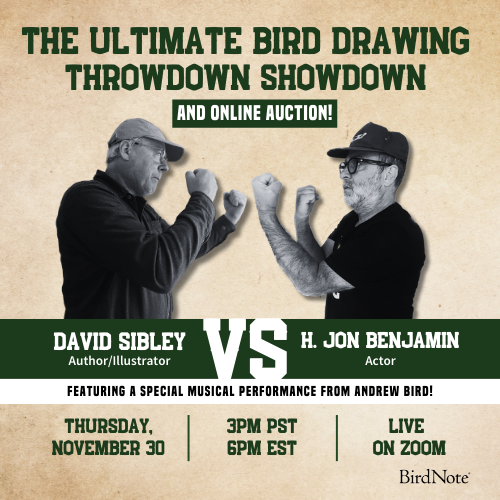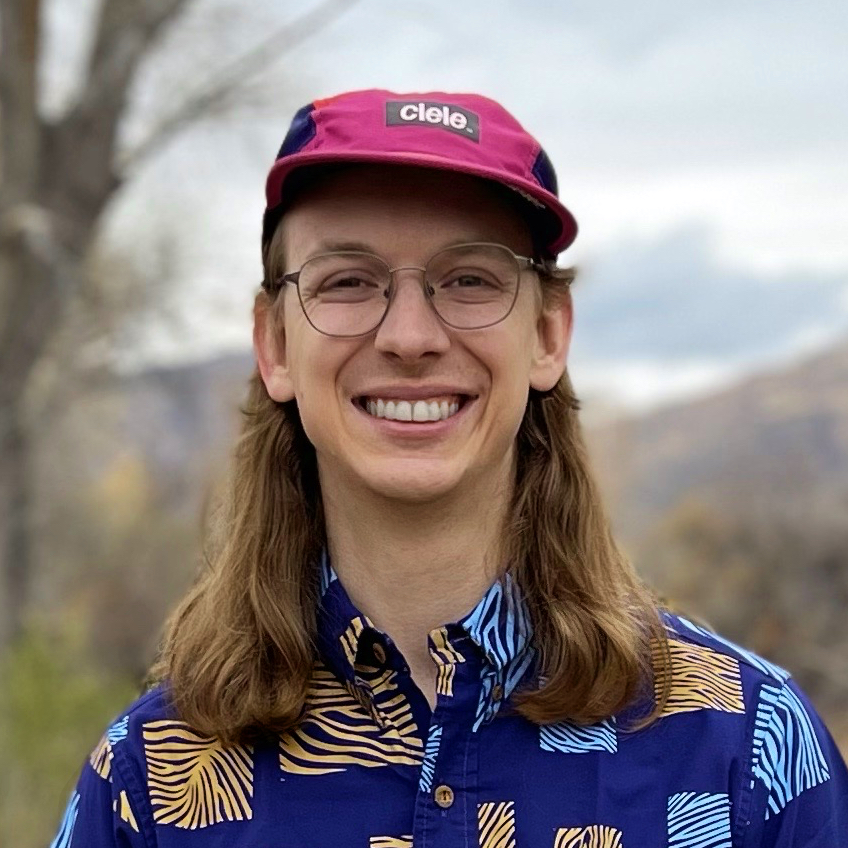

Join BirdNote tomorrow, November 30th!
Illustrator David Sibley and actor H. Jon Benjamin will face off in the bird illustration battle of the century during BirdNote's Year-end Celebration and Auction!
Poet Holly J. Hughes’ book Passings is a collection of poems about fifteen species of birds that we have lost, or presume to be extinct. For National Poetry Month, Hughes shares the inspiration behind her work and three poems: Passenger Pigeon, Northern Curlew, and Ivory-Billed Woodpecker.
BirdNote®
Poet Holly J. Hughes Honors the Birds We've Lost
Written by Mark Bramhill
Mark Bramhill: This is BirdNote.
Birds have always been a part of poet Holly J. Hughes’s life. One of her earliest memories is of a vibrant cardinal in the snow at her family’s bird feeder…
Holly J. Hughes: That's how I learned the color red. And I guess I just always have felt like birds have been part of my family. Or maybe I wanted to be part of their family.
As I've learned more about birds and their plight in terms of loss of habitat and climate change, and what some of them are doing with those long migrations, my respect for them only deepens. And I guess my concern for them has deepened also.
Mark Bramhill: That concern is what led to Holly’s book, Passings, a collection of poems memorializing fifteen species of birds that we’ve lost, or are presumed to be extinct.
For the project, Holly wrote in couplets, a traditional form in poetry — you know, pairs of two lines, often in the same meter, used a lot by Shakespeare. Usually rhyming, though not in these poems. The history of the form seemed to fit the birds, reaching back into the past. But as she was writing, she noticed new and unexpected ways that couplets matched her subject:
Holly J. Hughes: Just the shape on the page kind of resembles wings. And as I was finishing up the project and realizing how deeply interconnected we are with birds, our fate especially, I realized that, The couplets could also suggest that interconnection.
Mark Bramhill: The first of the poems she wrote — and the first in the book — was inspired by John James Audubon’s 1824 painting of a pair of Passenger Pigeons.
The Passenger Pigeon is maybe the most infamous modern extinction, going from unfathomably abundant to vanished in mere decades. On September 1, 1914, Martha, the last Passenger Pigeon, died in the Cincinnati Zoo. Here’s the poem, Passenger Pigeon:
PASSENGER PIGEON
Echtopistes migratorius
from the painting by J. Audubon, 1824. On Sept. 1, 1914,
Martha, the last Passenger Pigeon, died in the Cincinnati Zoo.
See how she bends to him, her beak held within his
while she waits for his food to rise up to her hunger.
He rests on the arcing branch, his neck a perfect answer to hers,
wings held aloft and slightly splayed while long tail feathers stream
away, Prussian blue going to dusk, breast russet, branch below
studded with viridian lichen to match his coat, colors chosen
by Audubon as he painted them in courtship in situ.
See how her colors foreshadow the fall — dun, mustard, black —
how her tail balances his wings painted in parallel planes,
how the drooping oak leaf holds them in place, stasis
in which they are aware of no one but each other.
Audubon captured them in gouache, graphite, and pastels,
not knowing they would soon be gone; in his time
they were more numerous than all other species combined.
They say the pigeons flew over the banks of the Ohio River
for three days in succession, sounding like a hard gale at sea.
Years later, guns splattered shot into skies stormy with pigeons.
Thousands plummeted, filling railroad cars bound for fine restaurants.
Now, of those hundreds of millions that once darkened
the skies, we are left with Martha, who never lived in the wild,
stuffed in the Smithsonian, Prussian-blue feathers stiff,
glass eyes staring, waiting, still, for her mate.
Holly J. Hughes: It's hard not to judge our ancestors for their actions. I suppose with such abundance, they thought they would never end, um, and, and yet they did. You know, those species that live in such great numbers, they're such communal birds that when their numbers drop, you really can't save the last one. They need to be in community.
I know that the Passenger Pigeon is kind of the iconic extinct bird species. And I really wanted to find out more about other species that were less well known. And that really started me on a couple year journey of researching extinct birds. Some of them I knew nothing about, like the Spix's Macaw, or the Labrador Duck, or the Heath Hen.
Mark Bramhill: One bird Holly knew she wanted to write about, though, was the Northern Curlew. As a child, she’d read the novel The Last of the Curlews, a fictionalized account of the life of the last of this species, and it made an impression on her.
NORTHERN CURLEW
Numenius borealis
I grew up reading The Last of the Curlews before bed,
your crescent-moon beak beckoning me north.
Even then you were almost gone, though millions of you
once filled the skies, migrating from the northern tundra
to South America, feeding on grasshoppers along the way.
Within twenty years, your vast flocks were brought down
by market hunters, fire suppression, tilling of the prairies,
eradication of grasshoppers. Before hunting was banned,
two million curlews were killed each year.
Here's the part that still makes me weep:
you were wiped out because you stayed
by your fallen companion; from you
I learned what loyalty means. Today, birders
search for you along Galveston's shore,
sometimes catch a glimpse, memory being so strong.
No one knows for sure you're gone. You live on
in the pages of a book, a waning crescent moon.
Mark Bramhill: Holly ends the book with a poem about the Ivory-billed Woodpecker. These massive birds lived in marshy old-growth forests along the gulf coast of the US and in Cuba. Deforestation made suitable habitat basically nonexistent; the last confirmed sighting was in 1948 in the US, and 1986 in Cuba. But over the years, there have been occasional unconfirmed sightings; shaky camcorder footage studied frame-by-frame, methodical searches across the South in hopes of seeing the bird. While presumed extinct, some birders are adamant that the bird is still out there somewhere. For Holly, the Ivory-billed Woodpecker represented a glimmer of hope — and wanted readers to feel that, too.
Holly J. Hughes: I wanted to end on kind of a plea to the reader. Whatever actions we can take to help protect the birds that are left, whether that's habitat, keeping our cats inside, or just getting to know the names of the birds in our yards, right? They're our neighbors, they're our family.
IVORY-BILLED WOODPECKER
Campephilus principalis
I wish I'd been at the sighting that inspired its nickname,
the Lord God bird. I'd love to see this woodpecker,
perhaps extinct, perhaps not; no one knows for sure.
Standing twenty inches tall with white wing patches
and a flashy red crest, who wouldn't say Lord God,
look at that? Once it made its home in the hardwood
forests of the south; birders say its ivory bill could pierce
bark eight inches deep. Imagine the racket. Even so,
they were vulnerable: a single pair needed six square miles
of wet forest with dead trees in which to search for grubs.
In 1948, when a Louisiana forest was cleared for a soy plantation,
the last population vanished. The Cuban subspecies survived
a few more decades, but by 1970, logging had reduced its population
to eight pairs. In the 1990s, explorers in the mountains near Moa
found fresh signs of feeding, caught a glimpse of a bird that may
have been the ivory bill, but that sighting was never confirmed.
Since then, more reports have surfaced, suggesting
the Lord God bird may not be gone. A few still hide,
spectral spirits, reminding us of the shimmering line
linking memory and desire, reminding us that perhaps
it's not too late to save them, to save us all.
Mark Bramhill: The Ivory-billed Woodpecker is the only species in today’s show that there are audio recordings of. Listening to the squeaky calls and beak tapping of this bird, recorded in 1935 — maybe I’m biased working in audio, but it feels like the bird is brought back for a moment, amidst the hiss and clicks of the old tape.
[Ivory-billed Woodpecker calling, ML6784, around 2:30]
Even if the Ivory-billed Woodpecker is gone, something about that gives me hope. Holly feels that way about the ivory-billed, too:
Holly J. Hughes: I'm always conscious when I share this book — I don't want it to be just a downer. I want it to inspire people to connect with the birds that are still here and take joy in them. I wanted these birds to be able to speak for the birds that are left.
[Ivory-billed Woodpecker tapping, calling, then flying away, ML6784, 3:18-25]
Mark Bramhill: All the poems you heard in this episode were adapted by composer Edie Hill for the choral work Spectral Spirits. You can hear a Grammy-winning recording of that work by the vocal ensemble The Crossing — we’ve got a link to that, and lots more poetry about birds, at our website, BirdNote.org. I’m Mark Bramhill.
###
Senior Producer: Mark Bramhill
Producer: Sam Johnson
Managing Editor: Jazzi Johnson
Managing Producer: Ariana Remmel
Content Director: Jonese Franklin
Bird sounds provided by The Macaulay Library of Natural Sounds at the Cornell Lab of Ornithology, Ithaca, New York. Ivory-billed Woodpecker ML6784 recorded by Arthur A. Allen.
BirdNote’s theme was composed and played by Nancy Rumbel and John Kessler.
© 2025 BirdNote April 2025
Narrator: Mark Bramhill
ID# HughesH-01-2025-04-04 HughesH-01


